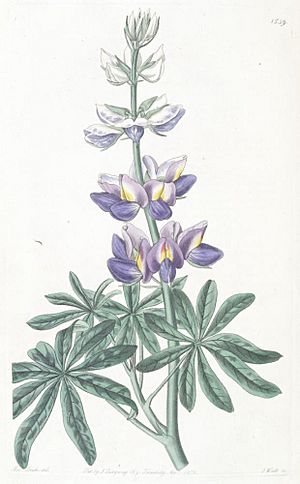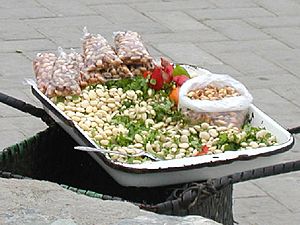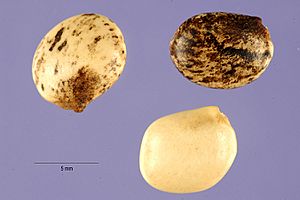Lupinus mutabilis facts for kids
Quick facts for kids Lupinus mutabilis |
|
|---|---|
 |
|
| Pisac, Peru | |
| Scientific classification | |
| Synonyms | |
|
Lupinus cruckshankii Hook |
Lupinus mutabilis is a special plant from the Andes mountains in South America. It's also known by names like tarwi (pronounced tarhui in Quechua II), chocho, altramuz, Andean lupin, and pearl lupin. People mainly grow it for its edible beans.
These beans are a great source of protein and can even be used to make cooking oil. Even though they are super healthy, they can taste a bit bitter. This is because they contain natural substances called alkaloids. But don't worry, modern ways of preparing them can easily remove this bitterness! Like other lupin beans, tarwi is becoming more popular as a plant-based protein source around the world.
Contents
Where Tarwi Comes From
Tarwi first grew in the Andean regions of Ecuador, Peru, and Bolivia. This area has the most different types of tarwi plants. People have been growing this plant for more than 1,500 years. They valued it mostly because of its high protein content.
All About the Tarwi Plant
Tarwi is an annual plant, which means it grows and produces seeds within one year. Its stem is hollow and has many branches.
How Tarwi Looks
The tarwi plant can grow from about 0.5 to 2.8 meters (1.6 to 9.2 feet) tall. Its height depends on where it grows and its specific type. Plants from northern South America are usually taller than those from the southern Andes.
The plant's fruit is a pod, which is like a long bean shell. These pods are about 5 to 12 centimeters (2 to 5 inches) long. Each pod usually holds 2 to 3 seeds, but some can have up to 9 seeds. The seeds are quite large, with 1,000 seeds weighing around 200 grams (7 ounces).
Tarwi leaves are shaped like a hand with fingers spread out. Each leaf has five to twelve smaller leaflets. These leaflets are oval or lance-shaped. The flowers are about 1 to 2 centimeters (0.4 to 0.8 inches) long. They come in many colors, from white to purple. The white color is less common than purple.
Tarwi has a strong main root that can grow up to 3 meters (10 feet) deep. Like other Leguminosae plants, its roots have special bumps called nodules. These nodules contain bacteria that help the plant take nitrogen from the air. This process is called nitrogen fixation.
Tarwi's Life Cycle
The time it takes for tarwi to grow from a seed to a mature plant varies. It can take anywhere from 150 to 360 days. This depends on the plant's type, how high up it is grown, and the weather.
The main stages of its growth are:
- Emergence: When the seedling first pops out of the ground.
- First true leaf: When the first real leaves appear.
- Raceme formation: When the flower clusters start to grow on the main stem.
- Flowering: When the plant blooms.
- Podding: When the pods start to form.
- Pod ripening: When the pods and seeds mature.
- Physiological maturity: When the plant is fully grown and its seeds are ready.
How People Use Tarwi
Eating Tarwi Beans
The bone-white tarwi seeds are very nutritious. They contain over 40% protein and 20% fat. People in the Andes have used them as food for a very long time. They often add them to soups, stews, and salads. They also eat them mixed with boiled maize.
Like other legumes, tarwi protein is rich in lysine. This is an essential amino acid that our bodies need. The healthy fats in tarwi include about 28% linoleic acid (omega-6) and 2% linolenic acid (omega-3). Tarwi seeds have a soft seed coat, which makes them easy to cook.
As mentioned, tarwi can taste bitter because of its alkaloid content. However, these alkaloids dissolve in water. So, people can remove them by soaking the seeds in water for a few days. Just cooking the seeds won't remove the bitterness, as the alkaloids can handle heat. More and more, tarwi beans are being used as a plant-based protein source around the world.
What's Inside Tarwi Seeds
On average, tarwi seeds contain 42% protein and 18% fat. Because of its high fat content, tarwi can even be pressed to make oil. The protein in tarwi is similar in quality to that found in soybeans.
Here's a quick look at what's in the seeds:
| Ingredient | Amount (%) | Range |
|---|---|---|
| Protein | 42.6 | 37.7 – 49.7 |
| Oil | 18.7 | 12.8 – 22.2 |
| Fibre | 6.27 | 4.29 – 7.51 |
| Ash | 3.69 | 3.10 – 4.24 |
| Carbohydrates | 27.3 | 23.7 – 29.9 |
| Alkaloids | 3.26 | 2.56 – 4.14 |
Wild tarwi plants naturally have bitter and toxic alkaloids. However, special types of tarwi plants, called Cultivars, have much lower levels of these alkaloids. This is thanks to special breeding programs that started in Germany in the 1930s.
Helping the Soil
Tarwi plants can take nitrogen from the air and put it into the soil. This is great for the soil! When tarwi is grown, it can add about 60 to 140 kilograms (132 to 309 pounds) of nitrogen per hectare (about 2.5 acres) to the soil. This means the next crops grown in that field will have more nitrogen to help them grow.
When farmers mix the tarwi plant into the soil during its flowering stage, it adds a lot of organic material. This also helps improve the soil's structure.
Growing Tarwi
Where Tarwi Grows Best
Tarwi is a plant that likes cool weather. It mostly grows in valleys at high altitudes, like the Andes mountains in tropical areas. It can be grown at heights ranging from 800 to 3,000 meters (2,600 to 9,800 feet) above sea level.
This plant can handle very dry conditions. Mature tarwi plants are also resistant to frost. However, young seedlings are sensitive to cold temperatures.
How Farmers Grow Tarwi
Sowing the Seeds
In traditional farming, farmers do minimal tilling (preparing the soil) before planting. They sow about 100 to 120 kilograms (220 to 265 pounds) of unselected seeds per hectare.
For better results, farmers can use improved methods: It's recommended to add about 80 kilograms (176 pounds) of phosphorus and 60 kilograms (132 pounds) of potassium to the soil before planting. Then, farmers sow about 90 kilograms (198 pounds) of selected seeds. They plant them about 60 to 80 centimeters (24 to 31 inches) apart. This can be done by hand or with a seed drill. Tarwi plants sprout quickly because their seeds have a high fat content.
Crop Rotation
Some types of tarwi grow quickly, taking about 150 days. These can be grown in a rotation with potatoes and cereals. Growing tarwi can even help control a potato disease caused by nematodes. This is because the alkaloids in tarwi can act like a natural pest control.
Harvesting Tarwi
Farmers usually harvest tarwi when the plants are fully mature. At this point, the seeds have a low water content, usually between 8% and 12%.
On small farms, the average yield is about 500 to 1,000 kilograms (1,100 to 2,200 pounds) per hectare. But in good conditions, the yield can reach up to 3,500 kilograms (7,700 pounds) per hectare!
Keeping Tarwi Healthy
Even though alkaloids in tarwi can act as a natural pesticide, farmers want to grow types with low alkaloid content for eating. So, they use other ways to keep the plants healthy. Since tarwi doesn't need many extra inputs, disease control is often done by keeping the fields clean.
Removing dry straw from the field can reduce harmful organisms in the soil. Instead of using the plant leftovers as green manure, they can be used as fuel. Diseases that spread through seeds can be reduced by producing seeds in different locations or by using certified seeds. If a farmer grows their own seeds, they can control diseases by removing infected seeds. They can also regularly check the field for diseases. Another option is to treat the seeds with a special spray before planting.
Improving Tarwi Plants
Scientists are working to make tarwi plants even better. They already have types with low alkaloid content. The next step is to make sure this low alkaloid trait is passed on reliably to new generations.
Other goals for improving tarwi include:
- Making plants more resistant to diseases and insects.
- Increasing the amount of seeds they produce (yield).
- Making them mature earlier.
- Making sure all the seeds ripen at the same time.
One idea is to breed a type of tarwi that has high alkaloid content in its leaves (to protect against pests) but low alkaloid content in its seeds (for safe eating).
See also
 In Spanish: Lupino para niños
In Spanish: Lupino para niños




